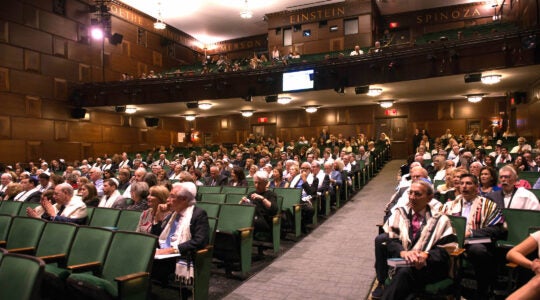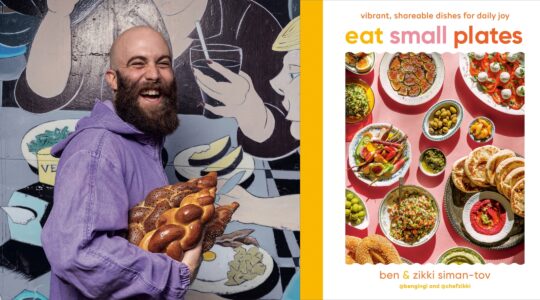Erica Frankel and Dimitry Ekshtut moved to Harlem a decade ago after meeting as New York University students. She now works at Hillel’s Office of Innovation, and he’s a public school music teacher and aspiring rabbi. They’re also both artists — a dancer and jazz musician, respectively.
Affordable rents drew them uptown initially, but they soon discovered other draws. They sensed that they could “really experiment. We just fell in love with this neighborhood, and have worked both through our efforts in the Jewish community and outside of it to try to be good neighbors and folks who are deeply invested in living here and in the wider neighborhood.”
Their strong ties to the neighborhood that teemed with Jews in the early decades of the last century, that still boasts handsome brownstones and has African-American cultural and political history around every corner, sparked innovation and entrepreneurship. In the past year or so, the couple co-founded Kehillat Harlem, a lay-led mechitza minyan that meets in a garage-turned-shteibel, and established Based in Harlem, which has brought over 450 millennials to their Shabbat table.
‘OK, Let’s Start Something’
A few years earlier, in 2012, that spirit of entrepreneurship took root during a moms’ chat at a Harlem playground when Elizabeth Mandel and three of her friends were discussing how best to spur egalitarian Jewish practice and women in leadership positions. Galit Mizrahi suggested forming their own such group, and thus the Harlem Minyan was born; it continues to meet today and the group is gearing up for next week’s Kol Nidre services.
“I don’t think we could have done this on the Upper West Side because there are so many options and so many choices,” said Mandel, executive director of jGirls Magazine and a Harlem resident. “But when you live in a place where there’s almost nothing [in terms of Jewish infrastructure], and there are a lot of people looking for something, you can stand in the playground and say, ‘Let’s start something,’ and the natural and easy response is, ‘OK, let’s start something.’”
Kyle Savitch, rabbinical student at Yeshivat Chovevei Torah, is now on his second stint in Harlem. Inspired by the reception he first received from Jews in the neighborhood when he lived there as a YCT student, he returned in February as a founding member of a chapter of the young professional programming nonprofit Moishe House to show others that same hospitality.
“I do truly feel that it’s one of the most welcoming Jewish communities in New York,” said Savitch, who added that Moishe House puts on about eight programs a month, from entrepreneurship workshops to whiskey and game nights to Shabbat dinners that draw between 20 and 50 young Jews. “You genuinely feel like the people there are caring that you’re there, and that you’re valued in the space, in a way that I don’t necessarily experience in all communities, and which I really do appreciate about the Harlem community.”
An Experiment In Community Building
As the Jewish revival of Harlem continues to evolve — there are now some 8,000 Jews and an 18-month-old JCC Harlem in the neighborhood — these Jewish Harlemites are part of what feels like a new experiment in community building. It’s one that’s part bottom-up and part top-down, and it offers a sharp contrast to the usual New York City gentrification stories where communities are often torn apart.
“What’s been really extraordinary here in Harlem is that there’s just a lot of harmony and purposeful collaboration, spirit of deep friendship and neighborliness among the people who live here and also entities that are building Jewish life here,” Frankel said. “I just think that’s so unique and can’t be understated.”
A key driver of that cooperative spirit is JCC Harlem, which opened its doors in January 2017 and occupies a four-story, 6,000-square-foot brick building on 118th Street between Frederick Douglass Boulevard and Manhattan Avenue. Initially a shared project of the Marlene Meyerson JCC on the Upper West Side and UJA-Federation of New York — which has pumped in some $1.5 million and is committed through June 2019 — the JCC Harlem is now partnering with dozens of local groups.
“They had a vision that it was not going to be their programming, that they would really roll out the welcome mat,” Melanie Schneider, senior planning executive in the Jewish Life Department at UJA-Federation, told The Jewish Week. “They would act as hosts in the community and bring in other partners and content providers who were really well positioned to be attractive to the Harlem community, and so I feel like JCC has really done that beautifully.”
Meg Sullivan, director of programs and community engagement at JCC Harlem (and featured in the most recent Jewish Week 36 Under 36), takes this idea even further, seeing the building’s offerings and experiences as running counter to current institutional trends.
“Our expressed goal is to create a diverse landscape of Jewish life rather than have a specific agenda,” Sullivan said. “I personally think that the Jewish community has gone a little too far in these messianic ideas … the idea that, ‘I have the one idea that is going to transform the Jewish community, everything will be different once this is born and funded and people come to it.’ We do exactly the opposite of that.”
In turn, the community has responded. In lieu of a membership structure, JCC Harlem estimates over 4,300 total program participants since opening its doors and hosting programs spanning from prayers by independent minyans (unlike its parent, the Marlene Meyerson JCC Manhattan, which legally cannot hold religious services), child care, Pilates, Israeli-targeted programming by Upper West Side shliach Hai Piasezky and even a social justice book group led by Ruth Messinger. A current show, “Summer Break: An Art Exhibition Curated by Art in FLUX,” features the work of more than a dozen largely black and Hispanic visual and spoken-word artists. Holidays like Sukkot and Chanukah have drawn members of Chabad (an early presence in the recent revival of Jewish Harlem) and egalitarian participants, and a non-fiduciary advisory council also represents the community’s range.
The “G” Word
All of this is part of a Harlem — no longer a majority African-American neighborhood — that has undergone rapid changes in the last decade or so. When Frankel and Ekshtut moved in just after the shock of the financial crisis, housing costs were still reasonable, by New York standards. A decade later, prices have soared.
According to the latest Elliman-Miller 2008-2017 Manhattan Decade Report, Harlem and East Harlem saw significant condo and co-op price increases, up nearly 21 percent in average sales price ($820,128) and a 44 percent increase in the number of sales, compared to a 15.8 percent uptick in all Manhattan sales over that span. Townhouses in all northern Manhattan (above West 116th Street and East 96th Street) saw a 57 percent increase in average sales price in the past decade, with the number of sales jumping from 36 in 2008 to 101 in 2017. (The townhouse report also noted that the area “led others in relative affordability” with sales falling “as lack of supply restrained activity.”)
Another indicator of change is the student body makeup of School District 3, which covers a third of Harlem as well as the Upper West Side; it has seen a decreased proportion of economically disadvantaged students eligible for free lunches, from 55 percent in 2012-2013 to 47 percent in 2016-2017. Rabbi David Gedzelman, president and CEO of the Steinhart Foundation for Jewish Life, who was instrumental in initially bringing the public charter school Harlem Hebrew Language Academy to life, notes that these figures represent a largely diverse population socioeconomically, as many public schools see either mostly affluent or mostly low-income students.
Yet Meg Okura, a Japanese-American jazz violinist and convert to Judaism, and Sam Newsome, an African-American jazz saxophonist, were disheartened with public school options in Harlem for their 7-year-old daughter, Naomi. In the face of what they perceive as racially determined zones, they opted for private education.
“In Harlem, it’s completely divided,” Okura said. “It’s really unfortunate and I think it’s horrifying to see those lines but that’s the reality. They make an exception for charter schools … for the neighborhood with this district division. I think it’s appalling and disgusting that they do that to make very unfair rules.”
Not surprisingly, given all the demographic changes, the “G” word — gentrification — is part of almost any conversation about the Jewish presence in Harlem. The situation on the ground, observers say, is a long way from what it was in 1991, when Rev. Al Sharpton referred to a Jewish landlord in the neighborhood as a “white interloper.” (That trope reappeared last year when City Council hopeful Thomas Lopez-Pierre railed against “greedy Jewish landlords” who are “pushing Black/Hispanic tenants out”; Lopez-Pierre lost bids for a West Harlem Council seat in 2013 and again last year.)
“The gentrification issue plays itself out in the legitimate expression of concern about economic viability for families that have been there for a long time, for their children to be able to find housing affordable near where they grew up, and that’s a real concern,” Rabbi Gedzelman said. He added that he has not seen the Jewish community itself targeted or identity politics blamed for the shifts taking place in Harlem. “To the credit of the community that’s been in the neighborhood for a long time, it hasn’t transformed itself into an attack on different groups. It stayed within expression of concern about housing.”
The situation is a sensitive one, both on a personal level for Jews in Harlem now and on a communal level.
“We want to talk about not just any feelings of personal guilt we might have about living here in this neighborhood,” Frankel said, “but how can we actively work within the neighborhood.” She said that the work would be “both through our connection to this particular community and also just to people who live here to mitigate the displacement of people who lived here for decades.”
At the same time, Mandel remembers unsafe streets and lack of fresh produce in grocery stores in Harlem, acknowledging the complexities that such changes bring.
“Along with gentrification comes more services and a higher quality of life for many, many people who have been here for many generations, but it’s very complicated,” she said. “I don’t know the solution. I’m both part of the problem and contributing to all the benefits that come with everything, but I don’t want to gloss over that there are real problems with it.”
For the JCC Harlem’s Sullivan, “The best thing we can do is continue to build thoughtful and honest relationships with community-based organizations that can somehow benefit from this space or something associated with JCC Harlem, whatever that is. And maybe their constituents will be more likely to walk in this door and be transformed a little bit.”
Many refer to warm relations within the neighborhood on an individual level, with anecdotal anti-Semitic incidents far and few between. Rabbi Yossel Gansbourg, whose late father Shaya founded Chabad of Harlem in 2007, runs programming on the ground floor of an apartment building and notes that neighbors even hold his mail, and vice versa.
“We live in a very diverse city and there’s a lot of different people from different backgrounds, and the reason why we get along so well is because we are all respectful of one another,” Rabbi Gansbourg said. “And that’s a very important thing to take into consideration, I think, in every interaction — always to be respectful of one another, and that when we are respectful of one another, people respect that as well.”
Okura also points out that the nonwhite population of Harlem is unfairly perceived as monolithic, sharing that her African-American/Asian-American family feels a closer kinship with white Jewish peers than with black neighbors who are long-time residents or more recent arrivals.
“There’s a whole assumption that people of color have so much in common or only white people can be different,” Okura said. “It’s just so outrageous, disheartening and almost sounds condescending to call us people of color as one thing because we’re so different. At the same time, I’d like to feel that we are not that different from a lot of Jewish people, our values and how we live our life.”
A Rich History
The Jewish story in Harlem stretches back more than a century. Jews first began arriving in the neighborhood in the late-1800s. Their numbers swelled around the time of World War I, with people being drawn, much as they would be 100 years later, by affordable rents and, for the early pioneers, by the northern extension of the subway.
The Jewish population in Harlem peaked at 175,000 around 1917, making it the third largest in the world behind Warsaw and New York City’s Lower East Side, according to Jeffrey Gurock, professor of Jewish history at Yeshiva University and author of the 2016 book, “The Jews of Harlem: The Rise, Decline and Revival of a Jewish Community.”
Some of this history was captured by the iconic novelist Henry Roth, who grew up in Harlem, in his four-part autobiographical novel “Mercy of a Rude Stream.” Writing in The New York Times in 1998, when the fourth installment, “Requiem for Harlem,” appeared, Allegra Goodman noted, “These novels are rich with details of immigrant life in Harlem in the 1920’s: the Yiddish spoken at home, the school fights and friendships, the calls of the street vendors.”
In the years after World War I, a number of factors combined to thin the Jewish population: congressional quotas, widespread race riots and government subsidies for undeveloped areas that encouraged lower- and upper-class Jews to leave. “The black elite can’t move out because of racism,” Gurock explained. “Poor blacks move into what is a declining neighborhood. … Jewish entrepreneurs remain, and Jewish life [here] ends in 1930.”
That history is not lost on current residents.
“We’ve got this amazing rich history that is here from our own tradition,” Frankel said. “I get so itchy and nervous about people saying, ‘You’re pioneers of Jewish life in Harlem.’ No way, we’re not pioneers of anything in Harlem. We happen to live here, we love it here, we’re inspired by the rich Jewish history here and we’re building Jewish community here.”
A Neighborhood Of Jews Or Jewish Neighborhood?
But what kind of community will it be going forward, in terms of Jewish engagement? Not a traditional one, that seems certain. The neighborhood’s diversity is a draw for many, including interracial Jewish families, who feel more welcome here in a way they don’t elsewhere in the city. Real estate agent Dianne Howard, who has lived in Harlem since 2001 and is in a mixed-race marriage, is mother to school-aged Zoe. The neighborly spirit drew her here, and she now serves on the JCC Harlem advisory council.
“We’re lucky to have this community,” Howard said. “Most synagogues don’t have people that look like [Zoe], so it’s much more than just a community. It’s personal.”
Gurock diagnoses the issue of Jewish engagement as a key challenge facing Harlem, though not unique to the area. “The vast majority of Jewish people who live in Harlem, like in other gentrified neighborhoods, are not particularly interested in being Jewish,” he said, “which is not a Harlem story, it’s a metaphorical story about our lives today as Jews. … Harlem is going to come back more and more as a neighborhood of Jews, but to what extent will it be a Jewish neighborhood?”
For their part, Rabbi Gansbourg and his family at Chabad of Harlem make it their mission to reach those new residents. He claims to be in touch with 400 households and a few thousand more via mailing list, and sees that there is more work to be done reaching Jews who are yet plugged into the Jewish scene.
“Most people didn’t come here because they’re looking for Yiddishkeit [a Jewish way of life], but there’s a lot of people to work with,” the rabbi said. “They didn’t consider that they’re going to have children, going to have religious needs, or that they want to have a community. They didn’t think about that. And here you go, you show up at their door and show them, ‘Here, please join us for Shabbat dinner, please join us for a holiday event,’ and people appreciate that.”
Journalist and Harlem resident Steven I. Weiss is concerned that while Jewish institutions and groups are thriving for those who are seeking them, the current communal structures are less visible than in other areas of the city and are possibly neglecting those who are less involved in Jewish life.
“It’s a lot easier to accidentally happen upon Jewish life on the Upper West Side or the Upper East Side, in the way that urban people do things,” Weiss said. “In the same way that people would happen upon Jewish life elsewhere, they’re not doing it here. It’s really just an example of a kind of inequality.”
The Next Act
According to urban legend, a goldfish only grows as large as its bowl. The same might be said for a 6,000-square-foot community center or a garage-sized prayer room. With limited space for its current institutions to expand, Jewish Harlem risks seeing its growth hindered as well.
In a 2015 article, “Analysis: Missed Opportunities for Jewish Life in Renewed Urban Neighborhoods,” in Contact, the magazine for the Steinhardt Foundation for Jewish Life, Weiss decried that “communal Jewish organizations and their leadership are mostly missing” the trend of urbanization. While progress has been made, he writes, “lack of communal real estate [is] stunting this growth opportunity.” In 2018, he still views this as an impediment to the growth of Harlem’s Jewish community.
“It’s very clear that the JCC Harlem has made a space and [presented] events that have made it possible for a great many families who otherwise would really do almost nothing Jewish in a year to do something Jewish,” Weiss said. “And one can only wonder what else could be done if there were more such spaces, if the spaces were larger, if the programming were offered more inexpensively.”
On the other hand, Mandel also sees the benefits of the tight-knit, adaptive community status quo. “Anything that gets institutionalized becomes less flexible, that’s the nature of life, that’s the nature of things,” she said. “But it’s also an opportunity because it means that we’re always going to have to bump up against one another, because we literally do not have walls between us.”
As the window for inexpensive local real estate has closed, further development may require capital from established organizations. The solution could lay in new building projects — such as those by Artimus Construction, which played a key role in JCC Harlem and Harlem Hebrew — that involve renovating a church, or, coming full circle, the site of a former synagogue.
“I think we’re going to run out of space,” Gedzelman said. “I think we need more space eventually for all the different things that are happening. Vibrant community needs to be multi-centered. So, how do we make it multi-centered?”
As Jewish Harlem transitions to its next act, residents on the ground share this confidence and enthusiasm for what the future holds.
“With JCC Harlem flourishing, we’re inspired by the potential of new models to engage a diverse and rapidly changing New York Jewish community,” said Eric. S Goldstein, CEO, UJA Federation of New York, in a statement to The Jewish Week.
“I don’t suspect for a minute that Jewish community in Harlem is going to stop or dwindle,” Erica Frankel said. “I think it’s going to grow over the next decade certainly, and I hope that we’re able to preserve this wonderful sort of sense of smallness and neighborliness that we’ve created. … We hope that Harlem can be an example for other parts of New York City, other parts of the country and perhaps other parts of the world.”
https://business.facebook.com/TheJewishWeek/videos/1746473202141751/
The New York Jewish Week brings you the stories behind the headlines, keeping you connected to Jewish life in New York. Help sustain the reporting you trust by donating today.




